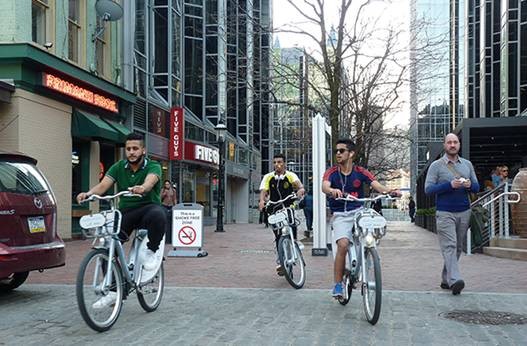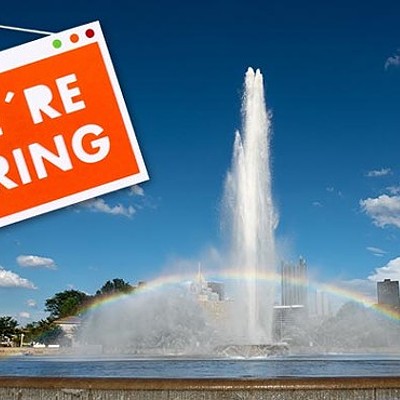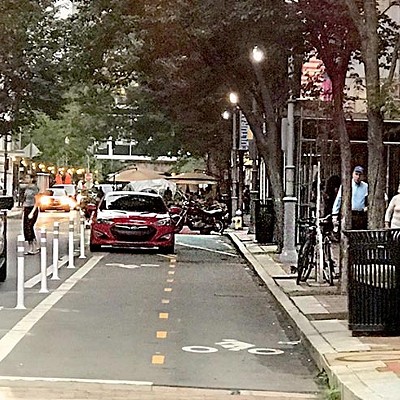Friday, March 11, 2016
Pittsburgh remains one of the country's most walked cities, says report
In case you didn’t know, Pittsburgh has some of the highest numbers of walkers of any major U.S. city, and has for some time now.
According to the Alliance for Biking and Walking 2016 benchmark report, Pittsburgh remains one of the highest walking-commuter cities with 11 percent of residents walking to work. (Census data from as far back as 2000 show similar figures.) For large cities, only Boston and Washington, D.C., had a higher percentage of walking commuters, according to the 2016 report.
Another stat Pittsburghers can be proud of is that the Steel City is in the top 10 for combined percentage of walking, biking or taking public transportation to work, at about 30 percent. (And a less scientific survey conducted by the city shows that same number at about 40 percent.)
As for bike commuting, the numbers only slightly rose from 2014 to about 2 percent, but it should be noted that survey data for the benchmark report was taken from the years before the installation of the Penn Avenue protected bike lane and many other bike-infrastructure projects. (Also the city survey showed bike commuting at 8 percent for respondents living within Pittsburgh.)
But not all the news is good news. The 2016 benchmark report shows Pittsburgh has a large disparity of low-income commuters who walk. While 17 percent of all commuters are low-income residents, about 29 percent of them walk. This 12-point disparity is far higher than in other high-walking cities like Boston and D.C., signifying the city’s walking figures could be high because many residents walk out of necessity.
However, those same walking figures could also be influenced by access. Pittsburgh has one of the highest percentages of sidewalks per square mile of any city — 36.8 miles of sidewalk for every square mile. (That’s 2,040 total sidewalk miles.)
And Mayor Bill Peduto's administration has installed new bike lanes; continued to increase the bike/ped budget; and committed to “complete streets” infrastructure (roads, sidewalks and bike lanes on all routes). The city is even a finalist to receive resources to address and boost more than 700 of city-owned steps.
But not every community in the area is jumping on board the pro-pedestrian train.
Mount Lebanon officials recently passed an ordinance that requires pedestrians to cross at marked crosswalks, or face fine up to $300. This despite the fact that there hasn’t been a pedestrian fatality in four years and pedestrian crashes have stayed level in the borough over the years. According to the Pittsburgh Post-Gazette, Mount Lebanon Police Chief Aaron Lauth said in defense of the new law: “Walkers have a responsibility ... for [their] own safety. I think it’s a regional problem. We have a lot of pedestrian entitlement here.”
The bike-and-pedestrian-advocacy group Bike Pittsburgh feels differently. The group’s advocacy director Eric Boerer says that by increasing enforcement on pedestrians, Mount Lebanon officials are ceding even more ownership of the road to cars. On a blog on Bike Pittsburgh’s website Boerer writes: “This car-centric way of thinking treats pedestrians as a menace to cars, instead of the other way around. Fining pedestrians will never get to the root of the issue: Signals and crosswalks in their current locations aren’t serving people.”
Boerer says in an interview with City Paper that the ordinance seems like an “easy way out” for city officials. “This doesn't seem to go to the root of the problem,” says Boerer. “Like cars speeding throughout their neighborhoods.”
And the benchmark numbers seem to go against Chief Lauth’s claim that walkers in the region have become less responsible. According to the benchmark reports, the average number of bike and pedestrian fatalities in Pittsburgh have decreased since 2014, even as the amount of bikers and walkers has remained the same.
Tags: BikePGH , Alliance for Biking and Walking , Mt. Lebanon , walking Pittsburgh , Image
















